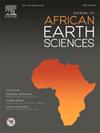Variations, paleoenvironment implications, and agronomic considerations of glauconite expandable layers: A case study from Egypt
IF 2.2
4区 地球科学
Q2 GEOSCIENCES, MULTIDISCIPLINARY
引用次数: 0
Abstract
As a contribution to many works conducted on glauconites, the current study represents an interdisciplinary approach combining geoscience and agronomy of these K-mineral resources, depending on the variations of expandable layers %. Through this context, two condensed sections of the Up. Cretaceous and Up. Eocene glauconites, located in the Western Desert of Egypt, were undergone field, petrographic, mineralogical, and geochemical investigations. The agronomic considerations were studied by simulating the organic acid-solubility of glauconite, using 2 % oxalic acid, in cases of its direct application as a slow-release K-fertilizer. Geologically, all of the studied glauconites were deposited authigenically by the neoformation of Fe-smectite precursor. The latter is thought to be more ferruginous in case of the Up. Cretaceous glauconite (nascent species, 3–4.1 wt% K2O) than the Up. Eocene counterpart (slightly evolved-evolved species, 5.05–6.71 wt% K2O). Depending on K2O contents and ethylene glycol solvation of glauconite grains, expandable layers were calculated and averaged at 40.53 % and 24.03 % for the Up. Cretaceous and Up. Eocene glauconites, respectively. Also, expandable layers showed a gradual increment from base to top of the studied sections where shoaling upward occurs. Depending on field observations, mineralogical, and geochemical data, along with literature, Fe2+ availability and sea level changes are found to be the main controlling factors of glauconite expandable layers. Agronomically, oxalic acid-based solubility tests showed that K+ ions aren't completely tightly fixed into the interstratified structure of the highly expandable glauconite, causing faster solubility rates than the less expandable species. According to the concept of slow-release fertilizers, the more evolved, less expandable glauconite deposits are preferred for the long-lasting K supply required by plants and keeping the soil fertility of plant macro-nutrients. On the other side, the smectite-rich glauconite can be exploited as a soil conditioner for enhancing its cation exchange capacity.
海绿石可膨胀层的变化、古环境意义和农艺考虑:以埃及为例
作为对海绿石进行的许多工作的贡献,当前的研究代表了一种跨学科的方法,结合了这些钾矿物资源的地球科学和农学,这取决于可膨胀层的变化%。通过这一背景,两个部分浓缩了起来。白垩纪及以后。对埃及西部沙漠始新世海绿石进行了野外、岩石学、矿物学和地球化学研究。采用2%草酸模拟海绿石的有机酸溶解度,研究了其作为缓释钾肥直接施用的农艺因素。在地质上,所有海绿石均为铁蒙脱石前体新生自生沉积。后者被认为在向上的情况下更含铁。白垩纪海绿石(初生种,3-4.1 wt% K2O)比Up。始新世对应(轻度进化种,5.05-6.71 wt% K2O)。根据K2O含量和乙二醇溶剂化程度,计算了海绿石颗粒的可膨胀层数,平均为40.53%和24.03%。白垩纪及以后。始新世海绿石。此外,可膨胀层显示出从底部到顶部的逐渐增加,向上发生浅滩。根据野外观测、矿物学和地球化学资料以及文献资料,发现Fe2+有效性和海平面变化是海绿石可膨胀层的主要控制因素。农艺学上,基于草酸的溶解度测试表明,K+离子没有完全紧密地固定在高可膨胀性海绿石的层间结构中,导致溶解度比低可膨胀性海绿石更快。根据缓释肥料的概念,越进化,越不容易膨胀的海绿石沉积物更适合植物所需的长期钾供应和保持植物宏观养分的土壤肥力。另一方面,富蒙脱石海绿石可作为土壤改良剂,提高其阳离子交换能力。
本文章由计算机程序翻译,如有差异,请以英文原文为准。
求助全文
约1分钟内获得全文
求助全文
来源期刊

Journal of African Earth Sciences
地学-地球科学综合
CiteScore
4.70
自引率
4.30%
发文量
240
审稿时长
12 months
期刊介绍:
The Journal of African Earth Sciences sees itself as the prime geological journal for all aspects of the Earth Sciences about the African plate. Papers dealing with peripheral areas are welcome if they demonstrate a tight link with Africa.
The Journal publishes high quality, peer-reviewed scientific papers. It is devoted primarily to research papers but short communications relating to new developments of broad interest, reviews and book reviews will also be considered. Papers must have international appeal and should present work of more regional than local significance and dealing with well identified and justified scientific questions. Specialised technical papers, analytical or exploration reports must be avoided. Papers on applied geology should preferably be linked to such core disciplines and must be addressed to a more general geoscientific audience.
 求助内容:
求助内容: 应助结果提醒方式:
应助结果提醒方式:


